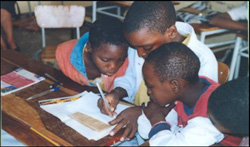 |
|
 |
 |
 |
|
USAID Information:
External Links:
|
|
 |
 |
|
You are here » Home » Telling Our Story
|
| Bringing Classrooms to Life In Namibia |
School teachers in the poorest regions are adopting interactive teaching methods
|
|
Challenge
Namibia is seeking to overcome an apartheid past in which the majority population received a poor, limited, and narrowly focused education — consciously designed to restrict choice and opportunity. Namibia is one of the few African nations to be within reach of achieving universal primary education access. Unfortunately, the tremendous gains in expanding access have not been accompanied by gains in quality. One of the problems is that the teachers themselves are undereducated and many, lacking knowledge of techniques to engage students, rely on lecture-style rather than interactive, student-centered methods of instruction.
Initiative
USAID is assisting Namibia’s Ministry of Basic Education, Sport and Culture to introduce and adopt reforms in grades 1-4 at schools in the nation’s poorest regions. Among the reforms making the greatest difference are those promoting student-centered education, whereby the teacher actively solicits the participation of students in presenting classroom lessons rather than presenting the lesson him or herself.
Reforms are introduced by a training team comprised of a circuit inspector, advisory teacher and resource teacher. Teams provide training for teachers and principals (who serve as instructional leaders) at school, cluster, circuit and regional levels. Techniques are modeled at teacher meetings and teachers are videotaped practicing the techniques with feedback from each other and the training team. A self-assessment is conducted and validated by outside observation to measure how effectively teachers implement the techniques.
|

|
Results
Teachers are now practicing student-centered instructional methods at almost 90 percent of the schools USAID is assisting. The total number of schools will reach 403 in 2004. Nearly 1,500 teachers and 283 principals have been trained in student-centered techniques; this initiative reaches approximately 63,430 students, 51 percent male and 49 percent female.
Students attending class in Oshikati provide a clear example of how this program is improving learning. Despite the worn desks and broken chairs, the classroom is a cheerful one with brightly decorated walls displaying students’ work and teaching aids. Students begin class by singing songs that familiarize them with the English words for different body parts. Next, the students identify the English words for items in a picture of a colorful birthday party and explain to each other in small groups the different actions that are taking place.
By acting as a facilitator as much as an instructor, the teacher has effectively shifted the focus of education from a “teacher-centered” one-way approach to a “student-centered” interactive approach. The teacher also becomes a resource model to assist other teachers to improve their
techniques at school-wide and circuit-level professional development workshops.
|
| Photo: Dr. Donna Kay LeCzel/AED
|
Students engaged in a group activity
“Helping teachers adopt learner- centered approaches to education is transforming education in Namibia.”
– Patti Swarts, Under-Secretary, Formal Education, Namibia
|
|
Print-friendly version of this page (244kb - PDF)
Back to Top ^
|


